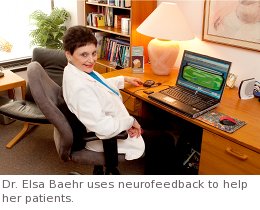“Integrative medicine” is a term everyone’s buzzing about these days.
Think of it as a mind/body approach to well-being that combines Western medicine with alternative treatments like massage, yoga and acupuncture.
IM, as it’s often called, isn’t just for reformed hippies. According to the American Hospital Association, the percentage of U.S. hospitals that offer alternative therapies has more than doubled the last ten years. For instance, in Chicago, Northwestern Memorial Hospital houses the Center for Integrative Medicine and Wellness. Some IM services, such as biofeedback and chiropractic treatments, are even eligible for reimbursement by insurance companies.
So before you go refill that prescription you’ve been taking for years, check out these basic facts about some IM therapies and local holistic hot spots:
 Acupuncture
Acupuncture
How it works: Thin needles are inserted into strategic points across your body. Proponents believe that stimulation at nerve centers rebalances energy, relieves pain and increases blood flow.
What it’s used for: Pain relief, insomnia, smoking cessation, infertility
Who practices it nearby: Northbrook’s Dr. Maxwell Barrett, of North Shore Physical Wellness Center, offers acupuncture for around $50 per session. Insurance is also accepted.
What to expect: The insertion of the needles (expect 5-20) will cause little, if any, pain. The acupuncturist will leave the needles in place for up to 30 minutes. “Keep in mind that acupuncture doesn’t work for everyone,” Barrett says. “It has a 2 out of 3 success rate.”
Neurofeedback
How it works: A therapist applies sensors to the scalp to view brain activity. After analyzing the brain waves, the specialist and patient work to increase positive brain functions, such as those that promote the release of serotonin, through specific techniques like relaxation.
What it’s used for: Brain injuries, depression, ADD, sleep disorders
Who practices it nearby: For $150 a session, Dr. Elsa Baehr offers treatment at her Skokie office. She offers a sliding scale.
 What to expect: The sensors that monitor your brain waves will send you feedback via cues, such as a flashing light or musical tone. Once you see or hear it, you perform whatever technique the therapist recommends, like deep breathing. “We did a big study comparing people who used medication or neurofeedback to control ADD,” Baehr says. “When people stopped using medication, the ADD symptoms returned. But the people who were treated with neurofeedback never relapsed. The results of neurofeedback are long lasting.”
What to expect: The sensors that monitor your brain waves will send you feedback via cues, such as a flashing light or musical tone. Once you see or hear it, you perform whatever technique the therapist recommends, like deep breathing. “We did a big study comparing people who used medication or neurofeedback to control ADD,” Baehr says. “When people stopped using medication, the ADD symptoms returned. But the people who were treated with neurofeedback never relapsed. The results of neurofeedback are long lasting.”
Feldenkrais
How it works: A practitioner verbally directs a patient in a series of gentle and complex exercises to help develop awareness of movement.
What it’s used for: Age related illnesses, chronic pain, stroke rehabilitation
Who practices it nearby: Mindful Movement offers both private and group sessions.
What to expect: No chin ups. The 30-60 minute sessions consist of ordinary activities, such as reaching, standing, and moving from the floor to a chair.
Massage
How it works: Massage therapists use their hands, elbows and even feet (along with objects like hot stones) to press, rub and manipulate skin, muscles, tendons and ligaments.
What it’s used for: Stress relief, pain relief, cancer treatment, blood pressure control
Who practices it nearby: Glenview’s Aphora Day Spa offers massages starting at $60.
 What to expect: Most massage therapists will ask you to get undressed before lying on a table and sliding under a sheet. But if you don’t feel comfortable sans clothes, let the masseuse know. Massage therapists usually use oils to reduce skin irritation, so let the therapist know if you’re prone to skin allergies. Remember that massages should feel good. If you ever experience pain during a massage, speak up!
What to expect: Most massage therapists will ask you to get undressed before lying on a table and sliding under a sheet. But if you don’t feel comfortable sans clothes, let the masseuse know. Massage therapists usually use oils to reduce skin irritation, so let the therapist know if you’re prone to skin allergies. Remember that massages should feel good. If you ever experience pain during a massage, speak up!
Holistic Health Counseling
How it works: A holistic health counselor focuses on the psychological and spirituality issues associated with eating.
What it’s used for: Weight control, eating disorders and other health issues like hypertension
Who practices it nearby: Karen Malkin meets with clients in her Glencoe home for $200 per month.
What to expect: Malkin meets with clients for two, one-hour sessions each month. She encourages clients to set their own goals. “We start with baby steps like adding in whole grains and leafy greens to one’s diet,” she says. She also provides clients such goodies as a personalized binder, food samples, dvds, and recipes.

